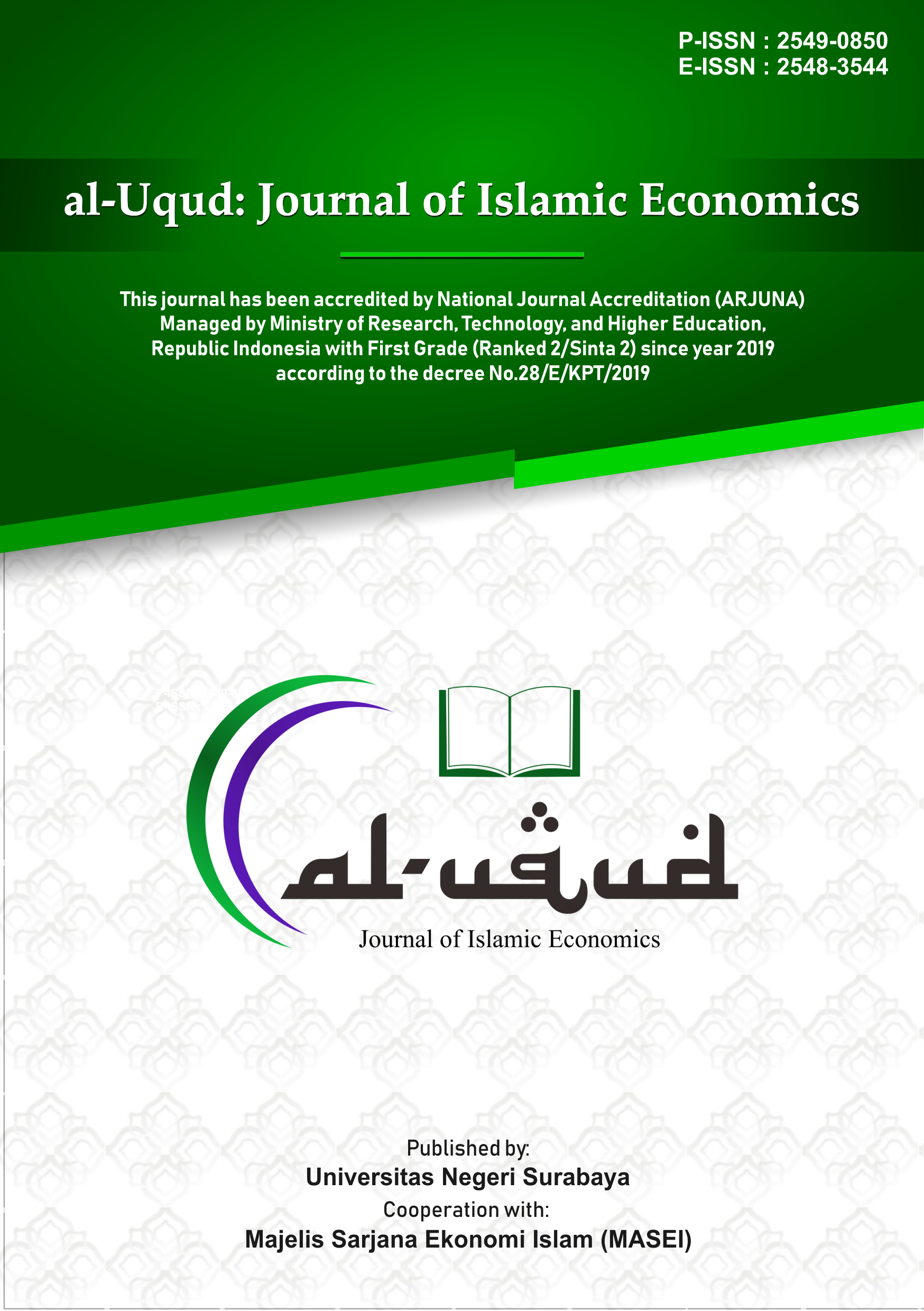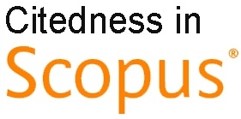Factors influence online donation during COVID-19 pandemic
DOI:
https://doi.org/10.26740/aluqud.v6n1.p66-83Keywords:
Non-cash payment , Online donation, PLS-SEM, UTAUT model, Covid-19Abstract
The Covid-19 pandemic has caused changes in human behaviour, including payment transaction methods from cash to non-cash. In addition, the National Non-Cash Program (GNTT) by Bank Indonesia (BI) also supports this new behaviour. This non-cash payment also occurs in donation payments, including zakat, infaq, alms and other Islamic social funds. This research analyses the factors influencing user behaviour (UB) towards the online donation from cash to non-cash. This study uses quantitative research within Partial Least Square – Structural Equation Modeling (PLS-SEM) tools. The data of this study is compiled by questionnaire on 124 respondents in East Java who made online donations during the Covid-19 pandemic (March 2020 – 2021). This research uses a technology adaptation model that is the UTAUT (Unified Theory of Acceptance and Use of Technology) model using the facilitating conditions (FC), performance expectancy (PE), effort expectancy (EE) and social influence (SI) variables. The results of this study indicate that (a) FC has a positive and significant effect on PE and SI, (b) PE and SI have a positive and significant effect on EE, and (3) PE and SI have a positive and significant effect on UB. Meanwhile, ease of donating online (Effort Expectancy) does not provide influence user behaviour of online donations. In addition, recommendations are also given to online donation organisations to improve collaboration, credibility and use of promotion media.
References
Alaeddin, O., Altounjy, R., & Zainudin, Z. (2018). From physical to digital: Investigating consumer behaviour of switching to mobile wallet. Polish Journal of Management Studies, 17(2), 18-30. https://doi.org/10.17512/pjms.2018.17.2.02
Ghozali, I dan Latan, H. (2014), Partial Least Squares: Konsep, Teknik dan Aplikasi Menggunakan Program SmartPLS 3.0, Penerbut Universitas Diponegoro Semarang (ISBN 979.704.300.2)
Hair, J. F., Hult, G. M., Ringle, C. M., & Sarstedt, M. (2016). A primer on partial least square structural equation modelling (PLS-SEM) (2nd Edition ed.). California: SAGE Publication
Beik, I. S. (2020). Zakat dan penanganan COVID-19. Direktur Pendistribusian dan Pendayagunaan BAZNAS RI.
Christiono, D. I., & Brahmana, R. K. (2018). Analisis pengaruh performance expectancy dan effort expectancy terhadap behavioral intention pada online marketplace. AGORA.
Crabbe, M., Standing, C., Standing, S., & Karjaluoto, H. (2009). An adoption model for mobile banking in Ghana. International Journal of Mobile Communications, 7(5), 515-543. https://doi.org/10.1504/IJMC.2009.024391
Djaghballou, C., Djaghballou, M., Larbani, M, Mohamad, A. (2017), Efficiency and productivity performance of zakat funds in Algeria. International Journal of Islamic and Middle Eastern Finance and Management, 11 (3), pp 374-394. https://doi.org/10.1108/IMEFM-07-2017-0185
Fahmi, S. (2017). Analisis Perkembangan Riset Pemasaran Tentang Perilaku Konsumen Dalam Melakukan Perpindahan Layanan (Consumer Switching Behavior), Menggunakan Studi Literatur. INOBIS: Jurnal Inovasi Bisnis dan Manajemen Indonesia, 1(1), 18 - 31. https://doi.org/10.31842/jurnal-inobis.v1i1.14
Farabi, N. A. (2016). Analisis Penerapan Sistem Informasi ZISW dengan Menggunakan Metode UTAUT. Indonesian Journal on Computer and Information Technology, 1 (2), 71-79. https://doi.org/10.31294/ijcit.v1i2.1524
Garson, D. (2016), Partial Least Squares Regression and Structural Equation Models, USA.
Hidayati, S., Nuryanti, I., Firmansyah, A., Fadly, A., & Darmawan, I. Y. (2006). Operasional e-money. Bank Indonesia, 1-5.
Ja-Chul, G., Sang-Chul, L., & Yung-Ho, S. (2009). Determinants of behavioral intention to mobile banking. Expert Systems with Applications, 36 (9), 11605-11616. https://doi.org/10.1016/j.eswa.2009.03.024
Jati, N. J., & Laksito, H. (2012). Analisis Faktor-Faktor yang Mempengaruhi Minat Pemanfaatan dan Penggunaan Sistem E-Ticket (Studi Empiris pada Biro Perjalanan di Kota Semarang). Diponegoro Journal of Accounting, 1(1), 511-524. https://ejournal3.undip.ac.id/index.php/accounting/article/view/562
Kana, K., & Ariyanti, M. (2018). Factors that Affecting Continuance Intention to use E-ticketing on KRL. e-Proceeding of Management, 5(3), 3698-3705.
Keaveney, S. M. (1995). Customer switching behavior in service industries: An exploratory study. Journal of marketing, 59(2), 71-82. https://doi.org/10.2307/1252074
Lim, F. W., Ahmad, F., Ikhsan, R. B., & Silitonga, K. (2020). The Role of Personal Innovativeness and Facilitating Conditions in Shaping the Attitudes of Mobile Internet Banking (MIB) Adoption among Generation Y in Malaysia. Preprints 2020, 2020030407 https://doi.org/10.20944/preprints202003.0407.v1
Mahri, J. W., Nuryahya, E., & Nurasyiah, A. (2019). Influencing Factors of Muzaki Use and Receive Zakat Payment Platform. Indonesian Conference of Zakat - Proceedings, 203-215. https://doi.org/https://doi.org/10.37706/iconz.2019.176
Oetari, R., Maryani, A. (2020), Analisis Perilaku Konsumen Dalam Berpindah Metode Pembayaran Dari Produk Berbasis Kartu Menjadi Digital (Studi Kasus: KRL JABODETABEK), Tugas Akhir Institut Teknologi Sepuluh Nopember (ITS), Surabaya
Oliveira, T., Faria, M., Thomas, M. A., Popovic, A. (2014). Extending the understanding of mobile banking adoption: When UTAUT meets TTF and ITM. International Journal of Information Management, 34, 689-703.
http://dx.doi.org/10.1016/j.ijinfomgt.2014.06.004
Otoritas Jasa Keuangan (OJK), https://www.ojk.go.id/id/kanal/iknb/Pages/IKNB-Syariah.aspx
Pertiwi, R.S., Herianingrum, S. (2020), Program Pemberdayaan Mustahik Pemuda dan Pengaruhnya Terhadap Kesejahteraan, Tesis Universitas Airlangga.
Raleting, T., & Nel, J. (2011). Determinants of low-income non-users' attitude towards WIG mobile phone banking: Evidence from South Africa. African Journal of Business Management, 5(1), 212.
Ryandono, M. N. H., (2009). Ekonomi ZISWAQ (Zakat, Infaq, Sadaqah dan Waqaf), Islamic Finance Development Institute (IFDI) dan Center For Islamic Economics (Cenforis).
Sivanthanu, B. (2017). Adoption of digital payment systems in the era of demonetization in India: An empirical study. Journal of Science and Technology Policy Management, 10 (1), 143-171. https://doi.org/10.1108/JSTPM-07-2017-0033
Sulaeman, & Ninglasari, S. Y. (2020). Analysing the Behavioral Intention Factors in Using Zakat Based Crowdfunding Platform in Indonesia: A Quantitative Study. International Journal of Zakat, 5 (3), 1-19. https://doi.org/10.37706/ijaz.v5i3.267
Sulistyowati, H. (2017). Analisis Penerimaan dan Penggunaan Pengguna terhadap Sistem E-Office di Universitas Airlangga dengan Menggunakan Model Unified Theory of Acceptance and Use of Technology (UTAUT). LIBRI-NET, 6(4), 21-22.
Suryani dan Hendrayadi. (2015), Metode Riset Kuantitatif Teori dan Aplikasi Pada Penelitian Bidang Manajemen dan Ekonomi Islam, Jakarta: Prenadamedia Group.
Venkatesh, V., Morris, M.G., Davice, G.B. and Davis, F.D. (2003), User acceptance of information technology: toward a unified view. MIS Quarterly, 27 (3), 425-478. https://doi.org/10.2307/30036540
Zhou, T., Lu, Y. and Wang, B. (2010). Integrating TTF and UTAUT to explain mobile banking user adoption. Computers in Human Behavior, 26 (4), 760-767. https://doi.org/10.1016/j.chb.2010.01.013
Downloads
Published
How to Cite
Issue
Section
License
Copyright (c) 2022 The author(s)

This work is licensed under a Creative Commons Attribution 4.0 International License.
CC BY 4.0 Abstract views: 676
,
Abstract views: 676
, PDF Downloads: 600
PDF Downloads: 600








